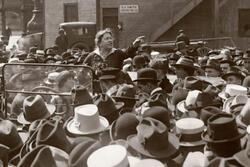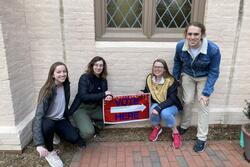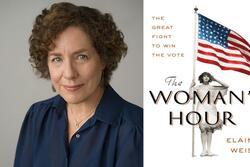Suffrage and the Fight for Reproductive Justice
This essay is part of JWA’s 2020 Suffrage Series on the blog.
As we approach the centennial of the Nineteenth Amendment, the Jewish Women’s Archive has revisited the history of women’s suffrage. The fight for voting rights is, unfortunately, as relevant as ever, and the coronavirus crisis has exacerbated existing voter suppression tactics. President Trump explained his opposition to adding voting reforms to the coronavirus stimulus package by saying, “They had things, levels of voting that if you’d ever agreed to it, you’d never have a Republican elected in this country again.” Trump’s attempts to limit access to the ballot are part of a long Republican agenda meant to limit the electorate to white suburban and rural voters. Barriers to voting—both before and after coronavirus—disproportionately disenfranchise people of color.
Voter suppression is one of many facets of reproductive injustice. Black women, who have always been at the forefront of the voting rights movement, are disproportionately harmed by abortion restrictions. Yet these restrictions are enacted by politicians elected in unfair contests from which Black voters are disproportionately barred. According to a 2012 report by Professor Elizabeth Chen at the Center for American Progress, “disenfranchisement removes [people of color] from the political process, and then it denies them a voice on matters that directly affect their lives, including their ability to access reproductive health care, make decisions about whether, when, and how to parent, and ultimately shape the course of their lives.”
This dynamic is apparent in two 2011 ballot initiatives in Mississippi. Initiative 27, a ballot initiative in support of arbitrary voter ID restrictions, succeeded. Initiative 26, a state constitutional amendment establishing fetal personhood, failed. Loretta Ross, one of the founders of the reproductive justice movement, explained before the election that “we have an excellent opportunity to experience an example of intersectionality in practice in an electoral campaign in which Black women may be the very voters we need to move the needle against our opponents’ long-term manipulation of the African American electorate.” Voting rights and reproductive justice are entwined human rights movements, and advocates can only affect true societal change by understanding the interdependence of justice movements. As Ross wrote, “Had the call of African American reproductive justice activists been heeded, we could have been stronger and united as two movements working together to save women’s lives and women’s votes.” Mainstream reproductive rights groups, largely led by white women, focused on the fetal personhood amendment, and did not perceive disenfranchisement as a threat to reproductive autonomy. Loretta Ross’s words remain a call to action to feminists today—and harken back to the same fractures and victories of the feminist movement a century earlier.
At the turn of the century, Jewish women activists were asking themselves if they wanted to participate in politics as usual, or transform society. In her excellently researched Ballots, Babies, and Banners of Peace, Dr. Melissa R. Klapper follows American Jewish women’s varied activism for women’s suffrage, birth control, and pacifism. Like Christian suffragists, Jewish suffragists were divided. Some were virulently racist, while others were racial justice advocates. Some were recent European immigrants working toward economic justice, while others were wealthy American philanthropists who wanted women to participate in the status quo. Some Jewish women activists, such as Emma Goldman and Rose Pastor Stokes, refused to engage with the suffrage movement at all, viewing it as mere window-dressing on an exploitative capitalist system.
Many Jewish suffragists also belonged to the nascent birth control movement, and the two movements were conflated by both advocates and detractors. Klapper writes, “Suffragists were denounced as free love radicals, and birth control activists were condemned as strident feminists.” Jewish women were at the forefront of the birth control movement from the beginning. When Margaret Sanger sought pamphleteers to advertise her Brooklyn birth control clinic, Rose Heiman Halpern was one of the first volunteers. Halpern, a working class socialist activist from Lithuania, viewed the birth control movement as a personal issue—she was also one of Sanger’s first patients. However, she also considered birth control a part of her broader political struggle for “the cause of all womanhood.” Similarly, Goldman, a trained midwife, called for birth control as a part of sexual and societal autonomy. Dr. Rachelle Yarros, a Jewish feminist writing in 1916, rejected the mainstream view that birth control would simply make women better mothers when she spoke of “the new ideal of sex, which embraces a single standard of morals for both men and women.” According to Klapper, even moderate, mainstream Jewish feminists participated in this more radical strain of birth control politics. This was in contrast to the mainstream birth control movement, which emphasized making married women better mothers, not promoting greater autonomy for women.
There is a rich history of Jewish birth control advocates and suffragists working to transform the traditional understanding of gender roles. Unlike many of their Christian colleagues, they paid particular attention to low-income women immigrants, creating a better understanding of what reproductive autonomy means in practice. Medical advocates, whose perspectives tended to be more broadly socially accepted than those of feminist activists, promoted birth control in Yiddish-language night classes for Jewish immigrants. Many suffragists considered the vote a key weapon for labor protections and social welfare programs. Jewish women’s movements were often involved in racist, ableist, and eugenicist politics—for example, Emma Goldman frequently published in the American Journal of Eugenics, and suffragist Rebecca Kohut argued that white women were more entitled to the vote than non-white men. While they claimed to be advocating for “the cause of womanhood,” most Jewish women advocates were solely focused on white, able-bodied women.
I hope advocates learn that the Jewish women’s movements were at their best when they worked from a transformative lens that took a diverse range of lived experiences into account. Author and advocate Mikki Kendall recently explained that, during the pandemic, “Basic needs are being unmet by feminism for women of color and for poor white women, too. Feminism isn't just failing low income women of color; it's failing everyone that's not an upper middle class white woman at this point.” A century past the failures of the Nineteenth Amendment and seven years after the gutting of the Voting Rights Act, activists must be committed to a true reproductive justice approach. That requires centering the leadership of Black women, passing the mic to directly impacted communities, and understanding that we belong to one human rights movement, not artificially divided issues like “birth control,” “abortion,” “childcare,” “healthcare,” and “voting.”







